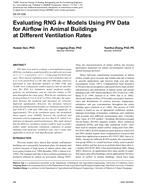Description
PIV data were used to evaluate a renormalization group (RNG) k-e turbulence model of airflow in a full-scale test room (5.5 × 3.7 × 2.4 m [18.0 × 12.1 × 7.9 ft]) using FLUENT software. Three typical ventilation cases with ventilation rates of 0.12, 0.26, and 0.90 m3/s (250, 560, and 1900 cfm), which are equivalent to inlet Reynolds numbers of 2300, 5500, and 16,000, were evaluated for airflow patterns and air distribution. The RNG k-e turbulence model predicted airflow patterns, air distributions, and air velocities similar to PIV data throughout the room space. With the air ventilation rate increased from 0.12 to 0.26 m3/s (250 to 560 cfm), the agreement between the predicted and measured air velocities improved significantly. However, the deviation between prediction and measurement under air ventilation rates of 0.26 and 0.90 m3/s (560 and 1900 cfm) was not significant. In approximately 70% of the ventilation space, the normalized mean square error (NMSE) between the predicted and measured velocity magnitude was less than 0.25, which is an indicator of adequate model performance. This study showed that the RNG k-e turbulence model could be used to predict airflow under isothermal ventilation conditions in animal buildings with moderate ventilation rates, but it seems only applicable to room air with high Reynolds numbers.
Units: Dual
Citation: ASHRAE Transactions, Vol. 113, pt 1, Dallas 2007
Product Details
- Published:
- 2007
- Number of Pages:
- 8
- File Size:
- 1 file , 2.3 MB
- Product Code(s):
- D-DA-07-038




